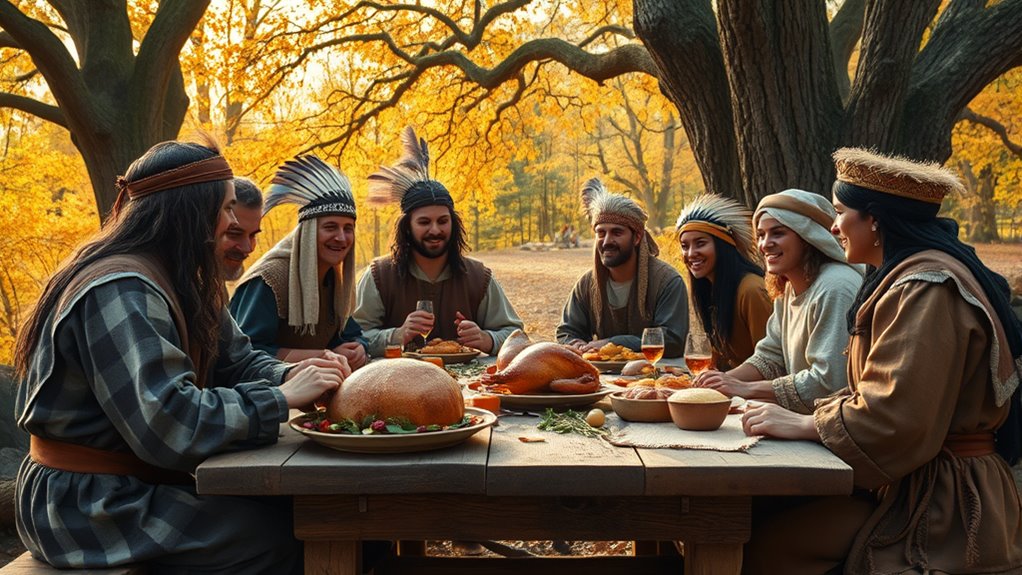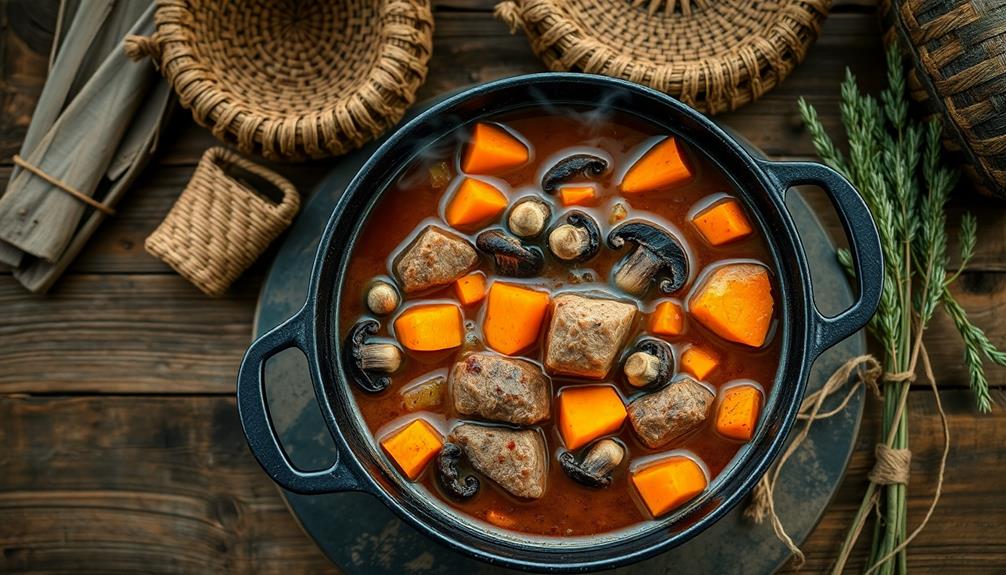The story of the first Thanksgiving begins with the Pilgrims landing in North America in 1620, facing many hardships. They relied on Native Americans, especially the Wampanoag tribe, who shared their land and resources. The harvest celebration in 1621 was a symbol of cooperation, gratitude, and survival, influenced by Native American traditions. Over time, this event evolved into an annual holiday highlighting gratitude, community, and shared history—if you continue, you’ll discover how these origins shape Thanksgiving today.
Key Takeaways
- The first Thanksgiving in 1621 was a harvest feast shared by Pilgrims and Native Americans, emphasizing cooperation and gratitude.
- Native American gratitude traditions predated the Pilgrims, involving sharing food, storytelling, and ceremonial practices.
- The harvest feast marked a moment of mutual respect and collaboration during a time of survival for both groups.
- Over time, the celebration evolved into an annual holiday reflecting Native American and Pilgrim traditions of gratitude.
- Modern Thanksgiving honors its roots of gratitude, community, and recognition of land and blessings across cultures.

Have you ever wondered how the tradition of giving thanks began? It’s a story rooted in early American history, blending the customs of pilgrims and Native Americans. When the Pilgrims arrived in North America in 1620, they faced harsh conditions, sickness, and hunger. Their survival depended heavily on the support and knowledge of Native Americans, who shared their understanding of the land and its resources. This mutual aid fostered a sense of gratitude that would shape a lasting tradition. The Pilgrims, influenced by their own religious beliefs, saw giving thanks as an essential part of their spiritual life. They incorporated elements of their pilgrim traditions—such as prayer and communal gratitude—into their harvest celebrations. These gatherings were not just about feasting; they were about showing appreciation for survival and the blessings they received from both their faith and their Native American allies.
Native American gratitude played a significant role in the origins of this holiday. The Native Americans, particularly the Wampanoag tribe, had long practiced ceremonies of thanksgiving long before the Pilgrims arrived. They celebrated successful harvests and gave thanks to their spirits and ancestors for a bountiful year. When the Pilgrims and Wampanoag people came together for the harvest feast in 1621, it was a natural extension of these traditions. The Native Americans’ gratitude was expressed through sharing food, storytelling, and ceremonial practices, which the Pilgrims observed and adopted. This act of coming together to give thanks became a symbol of cooperation and mutual respect, even if such harmony was often brief. Additionally, the enduring Native American gratitude traditions highlight the deep cultural significance of giving thanks beyond the colonial context.
Over time, this early feast grew into an annual tradition, especially after the Pilgrims established colonies and communities. The recognition of Native American gratitude and the importance of giving thanks became woven into the fabric of American culture. Today’s Thanksgiving reflects these origins, acknowledging both the Pilgrims’ pilgrim traditions and Native Americans’ profound appreciation for their land and resources. Understanding this history helps us see that giving thanks is more than a holiday; it’s a reminder of cooperation, survival, and gratitude shared across different cultures. As you celebrate, remember that this tradition has roots in the mutual respect and gratitude that helped early settlers and Native Americans survive and thrive. It’s a story about acknowledgment—of blessings, of others, and of the land itself—values that remain meaningful today.
Frequently Asked Questions
Were Native Americans Truly Invited to the First Feast?
You might think Native Americans were truly invited to the first feast, but from their perspective, it was more complex. Cultural misunderstandings played a role, and some believe they were invited in a way that didn’t fully respect their traditions. While the event included Native Americans, it wasn’t necessarily a genuine invitation like we often imagine today. Understanding this helps you see the event through a more nuanced Native American perspective.
Did the Pilgrims Intentionally Set a Tradition of Gratitude?
You might think the pilgrims intentionally set a tradition of gratitude, but their motivations were more practical than symbolic. They celebrated the harvest with a feast, emphasizing survival and community. The gratitude origins stem from their need to thank God and each other for a successful harvest, not necessarily to establish a lasting gratitude tradition. Over time, this event became a symbolic act of thankfulness, shaping future celebrations.
What Foods Were Actually Served at the First Thanksgiving?
You might imagine a feast with turkey, but at the first Thanksgiving, the menu was quite different. Native American agriculture provided corn, beans, and squash, which likely graced the table alongside venison and fish from local waters. The colonial menu was simple, relying on ingredients readily available, contrasting with today’s elaborate spreads. This blend of indigenous and colonial foods highlights the survival and cooperation that marked that historic harvest celebration.
How Did Thanksgiving Become a National Holiday?
You might be surprised to learn that Thanksgiving became a national holiday through colonial influences and Presidential proclamations. In 1863, President Abraham Lincoln declared Thanksgiving a federal holiday, encouraging Americans to unite in gratitude. This decision was influenced by colonial traditions and efforts by leaders like Sarah Josepha Hale. Thanks to these actions, you now celebrate Thanksgiving annually, honoring a longstanding history of gratitude and unity across the United States.
Are There Any Myths About the First Thanksgiving?
You might believe that the first Thanksgiving was a perfect, peaceful feast, but there are myths about Pilgrim origins and Native myths that challenge this. Some say the event was more about survival than celebration, and Native stories often highlight cooperation, not harmony. These myths remind you that history is complex, and what’s often told as a simple story isn’t always the full truth.
Conclusion
Now that you know the true story behind the First Thanksgiving, you can appreciate it even more. Remember, this feast wasn’t just a simple meal—it was a moment that shaped history and brought people together in ways that changed the world forever. So next time you sit down for a holiday feast, think of those brave souls who started it all. Their gratitude and unity are a legacy that’s bigger than any story you’ve ever heard.









